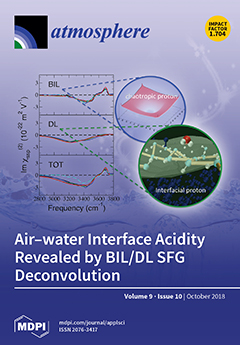Submicron particle (PM
1) pollution has received increased attention in recent years; however, few studies have focused on such pollution in the city of Shijiazhuang (SJZ), which is one of the most polluted cities in the world. In this study, we conducted an intensive simultaneous sampling of PM
1 and PM
2.5 in autumn 2016, in order to explore pollution characteristics and sources in SJZ. The results showed that the average mass concentrations of PM
1 and PM
2.5 were 70.51 μg/m
3 and 91.68 μg/m
3, respectively, and the average ratio of PM
1/PM
2.5 was 0.75. Secondary inorganic aerosol (SIA) was the dominant component in PM
1 (35.9%) and PM
2.5 (32.3%). An analysis of haze episodes found that SIA had a significant influence on PM
1 pollution, NH
4+ promoted the formation of pollution, and SO
42− and NO
3− presented different chemical mechanisms. Additionally, the results of source apportionment implied that secondary source, biomass burning and coal combustion, traffic, industry, and dust were the major pollution sources for SJZ, accounting for 45.4%, 18.9%, 15.7%, 10.3%, and 9.8% of PM
1, respectively, and for 42.4%, 18.8%, 12.2%, 10.2%, and 16.4% of PM
2.5, respectively. Southern Hebei, mid-eastern Shanxi, and northern Henan were the major contribution regions during the study period. Three transport pathways of pollutants were put forward, including airflows from Shanxi with secondary source, airflows from the central Beijng–Tianjin–Hebei region with fossil fuel burning source, and airflows from the southern North China Plain with biomass burning source. The systematic analysis of PM
1 could provide scientific support for the creation of an air pollution mitigation policy in SJZ and similar regions.
Full article





